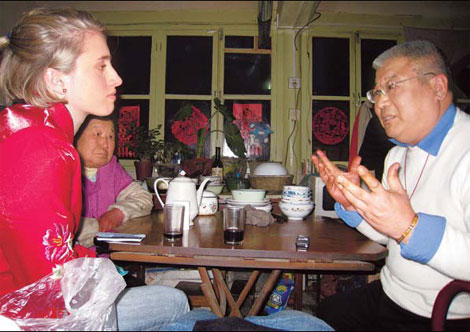Profile
Retired teacher launches second career as story-teller
By Li Jing (China Daily)
Updated: 2010-03-16 09:53
 |
Large Medium Small |
|
 COURTESY OF LIU HONGJUN
Liu Hongjun tells stories of the city to a visiting foreign student. |
Stories of Beijing's past bridge thegap between generations, cultures
A five-room courtyard house, surrounded by apartments and hotels in the Dongsi Shitiao area, is home to 60-year-old Liu Hongjun, a retired primary school teacher who now guides American students around the city.
"Before 1958, Chaoyangmen Tower Gate was 10 minutes' walk from my home, and a lotus pond near the gate was my favorite haunt after school. I loved to catch dragonflies here at dusk," he recalled. But all these disappeared when the Second Ring Road was constructed.
"From the Temple of Heaven and the Forbidden City to Qianmen and Nanluo Guxiang, places of historical interest are the best way to learn the history and culture of the city," he said. "Economic development and modernization are changing the city a lot and few people know the history and stories behind these changes."
Walking past a Neiliansheng shoe store that dates back to 1853 in the Qing Dynasty, Liu said that the salesmen would always offer customers shoes that were too big at first, even though they had a good idea of the correct size, because giving someone a pair of smaller shoes suggested being mean to someone in Chinese culture.
"My father told me about this, when I followed him to buy shoes decades ago," Liu said.
Liu now tells stories such as these to the American students that visit him and who he escorts round the city on Sundays. Since 2008 he has accompanied 16 American students under the auspices of the Associated Colleges in China (ACC) on their explorations of Beijing.
Liu was a mathematics and biology teacher at a primary school until two years ago, when he found it hard to look at computer screen for a long time and had to retire. But he was still determined to contribute to society.
"The moment I retired, the Sichuan earthquake broke out. Inspired by the nation's struggle to help those devastated by catastrophe, I volunteered to go to Sichuan. However, I was declined because of my age."
Undeterred, Liu decided to become a volunteer for the Olympics. In order to qualify he started to learn English at a class held in his area. "'Go along', 'turn right', 'take bus 11'," said Liu, "just a few short phrases, but they were very practical when I helped foreigners with directions at a volunteer pavilion."
Liu's daughter was surprised at his father's interest in communicating with foreigners and asked him curiously, "Can you speak English?"
"I don't know much but I can learn it from now," Liu replied.
Impressed by his determination, his daughter contacted the ACC and applied to be a Chinese host family for exchange students every Sunday. Most of the students are college students from the United States, who come to China to study Chinese for a period, usually between three months and a year.
"It's a good way to understand their way of thinking and lifestyle, as well as learn English," Liu said.
His interest in people of other nationalities was sparked in the early 1960s, when the Sunlitun embassy district came into being, and he saw his first foreigners, "My friends and I were very curious at these people with blond hair or dark skin and followed them for a long time to see what they were talking about and what they looked like."
The first students to come to his home were an American boy and a Korean-American girl, one week after their arrival in Beijing.
"What I can offer is a warm welcome on the other side of the world from their family in the United States."
On the eve of the Year of the Tiger, Timothy Kau and Veronica Chiu, who had arrived in Beijing last November came to his home. "I prepared a suit of Tang clothing for each. As I was not sure about their size, I told the vendor in advance to exchange them if they didn't fit."
He told the students that, "Wearing new clothes, making dumplings and setting off fireworks are the three must-do's at Chinese New Year."







